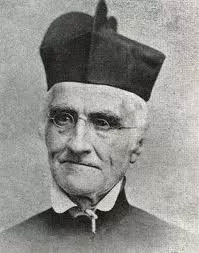
Fr. Ferdinand Helias
~ Parish History ~
It was in the summer of 1838, that the saintly Father Helias came to this area to care for the souls of the German immigrants. Only 20 families comprised the congregation, when Mass was first said on May 28, 1838.
Shortly after, 10 acres of land was purchased from Henry and Gertrude Haar for $5.00 to be used for a church and school. The year 1840 saw the erection of the first church, a rather crude and simple log structure dedicated to St. Francis Xavier, a famous Jesuit missionary to India. The site of the Parish was named Haarville. It was so called for many years; but when some soldiers came back from the war with Mexico who had fought in the Battle of Taos and Sacramento, the town was forever referred to as Taos.
On April 6, 1844, the cornerstone of the new church was laid, which would claim the distinction of being the first stone house of worship to be built in the interior of the state of Missouri. More than a year lapsed before the new 60X30X30 edifice was ready for occupancy.
In 1842, Father Helias transferred his residence from New Westphalia to Taos, and from that year until his death he lived amongst the people he loved, and whom he served so faithfully for so many years. On the morning of August 11, 1874, the “Apostle of Central Missouri” was found lying in the yard near the church – a stroke had ended his life. He was buried in the little cemetery in Taos where he remained until 1964. On February 29 if that year, he was moved to St. Francis Xavier Church.
Under the Pastorate of the Reverend John Gruender, in 1881 plans were made for the erection of a new church, the old rock church built by Father Helias having become too small to house the congregation. This was the third church to be built in Taos, and still stands firm and solid today, a tribute to the zeal and faith of the people at the time. With the exception of improvements, church furnishings, modifications and beautification, the present church is the same as it was in 1883, the year in which it was dedicated to the Honor and Glory of God.
The present structure was built in 1883 and is the third home to our congregation. Its walls are twenty-two inches thick, and they were constructed from rock from a nearby quarry. The brick, which form the exterior were hand made in the community. This church, built in the Romanesque Revival style, cost $9,000 to construct. The bell tower rises 190 feet and houses three bells that were cast in St. Louis by the Henry Stuckstede Foundry. Parishioners whose names are inscribed on the bells donated these. The bells were dedicated in 1893 to the honor of St. John.
A thirteen-register pipe organ was added to the church in 1898. It has undergone restoration in 1940 and more recently in 1994.

Our history of the church is sketchy, but we know the church was renovated in 1955 at a cost of $72,000 which is eight times the original construction cost. At this time new windows were installed to replace the originals which had deteriorated. The building was again painted and carpeted in 1974. The last major restoration work was completed in 1984. A parish-wide campaign raised $300,000 to do this work as well as several other parish projects.
The present restoration has truly been the work of our entire community. The financial campaign, “Our Parish, Our Future” raised nearly $1.5 million for work in our church and our school. The work in the church was guided by three principles: take care of what we have, prepare for the future and do it right. Our parish takes pride in believing that these principles have been fulfilled.
~ The Crypt of Fr. Helias ~

On the morning of August 11, 1874, Father Ferdinand Helias, the “Apostle of Central Missouri,” was found dead in the churchyard. Legend tells us he died while ringing the Angelus. Father Helias was buried in the parish cemetery, which was located down the road. In 1964, during the pastorate of Msgr. Poelker, Father Helias’ body was exhumed. It was re-interred in the entry of the Church on Memorial Day. One year later Bishop Marling, the first bishop of the Diocese of Jefferson City, dedicated the memorial to Father Helias.
